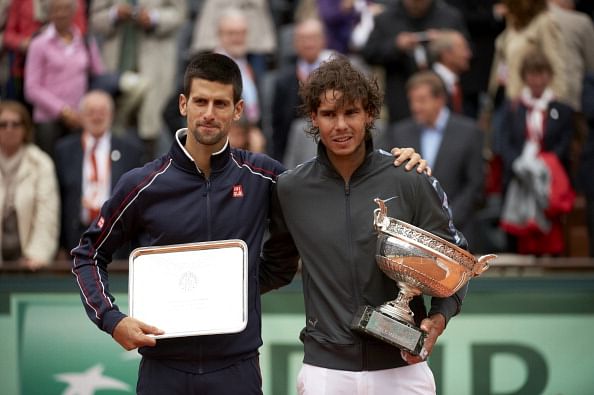
Seeding and points system: Should there be a change?

Nadal and Djokovic: Last year’s French Open finalists will potentially meet in the quarterfinals this year
Do you see Wimbledon as a rebel? The quirky word is usually not associated with the traditional and classy tournament that is recognized as the Holy Grail of tennis. Although the tournament organizers don’t exactly break any rules, they do seed the players in a unique fashion. When the rest of the world decides to rank players in terms of their ATP points, the All England Club does so based on players’ past performances on grass. This makes sense, because the ATP awards players the prize money and points based on their advancements to each stage of the tournament and it’s only fair that grass-focused players are evaluated and awarded differently. However, Roland Garros uses the conventional seeding system, meaning that the King of Clay, Rafael Nadal, would in all probability be seeded 5th this year at a tournament where his winning rate is 98%. This would foreshadow a potential meeting between Nadal and Djokovic at only the quarterfinals, which was the 2012 French Open final match up! Is this reasonable or fair?
Let’s focus on All England Club
As we know, different surfaces in tennis equip players with different playing styles because of the varying textures of the surfaces. Grasscourts give an advantage to players who tend to serve big and come to the net often. However, this Grand Slam event only has a few small lead-up tournaments unlike the numerous Masters 1000 and 500 tournaments that precede other Grand Slams. Therefore, players who play extremely well on grass would not be able to rack up enough ATP ranking points to boost their rankings and display their true ability on grass. Therefore, the tournament organizers decided to evaluate players with consideration for their past grasscourt results.
The red clay in Paris, however, has numerous lead up events, such as Monte Carlos and Rome, to allow the clay experts to boost their rankings. Although this makes sense, Rafael Nadal, who just came back to tennis from a 7 month hiatus, would not benefit from the European clay tournaments coming up. This is because Nadal’s current ranking points are almost all from clay tournaments, meaning that he has to defend a lot of points and has little to gain. Even if he wins nearly all the matches prior to the next Grand Slam, he could still be ranked 5th.
History on the red clay
This is not the first time that the seeding is imbalanced. For instance, the recently retired Andy Roddick was poor on clay even in his prime. A-Rod was seeded number 2 in 2004, number 2 in 2005 and number 5 in 2006. Although he was seeded highly, he never came close to winning in France. As a result, players in Roddick’s bracket had more chances to get past the quarterfinals. This year, the opposite may happen. Should the previous year’s champion and runner-up be forced to meet prematurely? Should the current top 4 seeds play Nadal, who has only lost 1 match on Paris clay in the past 8 years?
The seven-time French Open winner, on the other hand, would also not like to face Djokovic, Murray or Federer too early. The reason for this is that Grand Slam tournaments are very physically draining. These events run on best of 5 sets and require players to win 7 consecutive matches before putting their hands on the trophy. For Nadal, this would mean that he would, in all likelihood, play 3 back-to-back 5 setters from the quarterfinals to the final – a total of 14-15 hours. Fresh from an injury hiatus, this possibly could not be very good for Nadal’s troublesome knees. Although the seeding system is representative of a player’s performance in the past 12 months, it definitely does not leave any consideration for players who have missed out on numerous tournaments.
Continue the folly or change the traditions

The 2012 US Open made it clear how inconsistent the seeding system is
This problem is not the first. For instance, Serena Williams, the 2012 US Open winner, was seeded 28th at the 2011 US Open. She had to face Victoria Azarenka, who was seeded 4th and was the runner-up at the 2012 US Open, in the first week of the tournament. All the dominant players who have had time off the tour have had to go through this process. Should there be a different seeding system on the ATP tour? Last month, at Indian Wells, Nadal faced Federer at a stage before the semifinals for the first time since 2004. Ironically, the Indian Wells 2012 winner and runner-up also had to duel very early on.
In reality, ATP points are simply numbers. Tournament organizers would do well to put more effort into making the game more fair and balanced. If a top player is seeded lowly because of an injury and is currently playing strong tennis, shouldn’t the points and seeding be reconsidered? One can only hope the ATP finds a way to ensure the best players have a fair chance of making it to the advanced levels of the tournament.